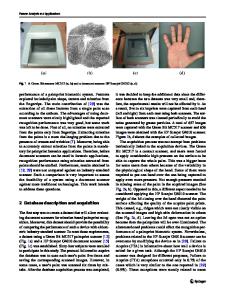An effective recognition approach for contactless palmprint
- PDF / 1,662,251 Bytes
- 11 Pages / 595.276 x 790.866 pts Page_size
- 67 Downloads / 340 Views
ORIGINAL ARTICLE
An effective recognition approach for contactless palmprint Nuoya Xu1,2 · Qi Zhu1,2 · Xiangyu Xu1 · Daoqiang Zhang1
© Springer-Verlag GmbH Germany, part of Springer Nature 2020
Abstract The biometrics character has been widely used for individual identification and verification. Palmprint as one of biological features contains abundant discriminative features, which has already attracted a lot of interest. In this work, we focus on the identification and verification of contactless palmprint images. Considering the main differences between contact and contactless images, including orientation and deformation, we use a deep network combined with image alignment to further improve the recognition performance of contactless palmprint images. Recently, convolutional neural networks can well solve many classification problems, and researchers have proposed many networks with different architectures. We exploit the residual network in our framework, which achieves promising performance on the image classification problem. In order to improve the accuracy of verification, the spatial transformation network is used to align the image. The proposed method is tested on two public palmprint databases CASIA, GPDS. Extensive experiments are carried out with several state-of-the-art approaches as comparison, and the results demonstrated the effectiveness of our method. Keywords Biometrics · Contactless palmprint · Spatial transformer networks · ResNet
1 Introduction In recent years, biometric characteristics have been widely used in recognition systems [1]. Compared to other identification methods such as password and key, the biometric traits are more reliable, because they are unique and cannot easily be duplicated [2]. The iris [3], face [4], vein [5], fingerprint [6], palmprint, and other biometric traits have been extensively used to authenticate individuals. As one of relative emerging biometric features, palmprint has increasingly attracted interest in recent decades, since it contains abundant discriminative features including principal lines, wrinkles, ridges, and minutiae points [7]. In addition, palmprint-based recognition applications are user acceptability, fast speed, high-recognition rate and works in low-resolution imaging [8]. In general, palmprint-based biometric plays an important role in addressing the issue of authenticating individuals.
B
Qi Zhu [email protected]
1
College of Computer Science and Technology, Nanjing University of Aeronautics and Astronautics, Nanjing 211106, China
2
Collaborative Innovation Center of Novel Software Technology and Industrialization, Nanjing 210093, China
To date, the researchers have proposed various methods for palmprint recognition [9,10], most of which can achieve the desired performance. The palmprint recognition methods can be generally divided into five categories: structural, statistical, coding, appearance, and fusion [11]. The structural methods use the intrinsic features, such as principal lines and wrinkles, for identifying the individu
Data Loading...











